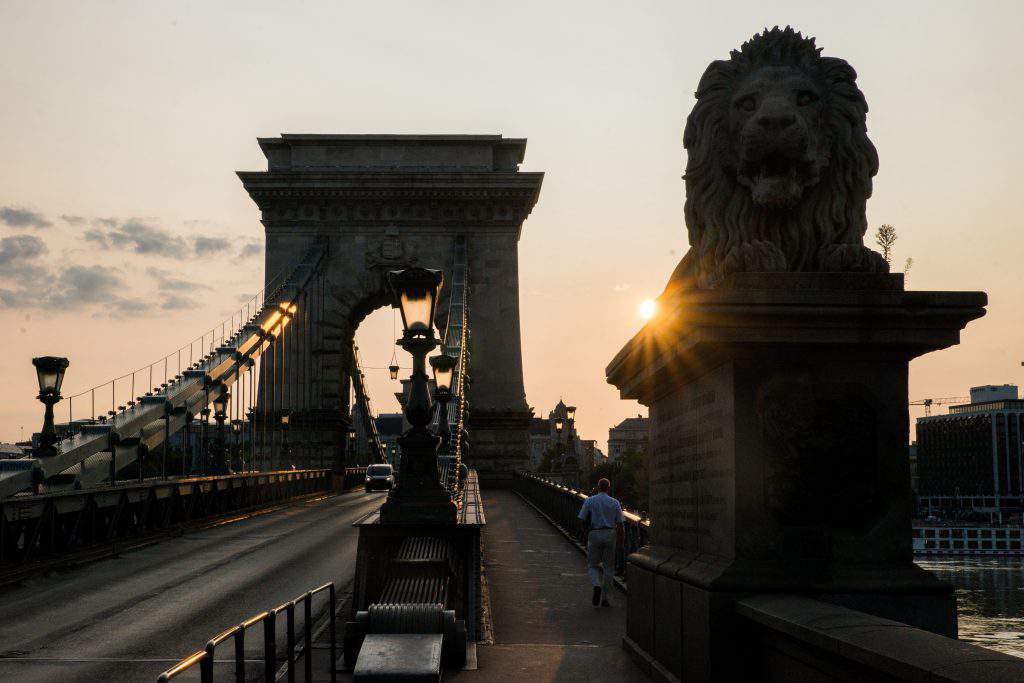The 175th anniversary of the laying of Chain Bridge’s foundation stone
According to rubicon.hu, Palatine Joseph laid the foundation stone of Chain Bridge’s Pest pillar 175 years ago, on the 24th of August, 1842 in the company of the country’s respectabilities. The 380 metres long construction, which was the first significant and permanent riverine bridge of Hungary, was inaugurated in the November of 1849, after a decade of hard work.
The idea of a bridge over spanning the Danube arose in the 18th century, but it would’ve been impossible to build a stable and safe bridge with the available technical solutions. The river’s drifting would’ve destroyed medieval stone bridges, and people were also concerned that a construction like this could cause floods. Later, the biggest argument was that István Széchenyi wanted to introduce a general pontage, which would’ve offended the tradition of noble tax exemption. Still, “the greatest Hungarian” founded the Bridge Association in 1832, through which he wanted to get the support of the richest Hungarian entrepreneurs.

After long fights, Széchenyi managed to convince Baron György Sina to financially support the construction of the bridge. This is how the Chain Bridge Corporation was born in 1836, when Széchenyi already had a concept in his mind, since he consulted the greatest engineers of the time, e.g. Thomas Telford. Count Széchenyi met William Tierney Clark in England, who undertook the preparation of the plans, which he presented in 1839. Meanwhile, the Viennese Rothschild family and the Pest Wodianer family joined Sina’s corporation, which meant that they had enough capital to start the construction, which cost 13 times more than the building of the National Museum.
The construction of the bridge was enacted at the 1839-40 parliamentary session, the corporation got hold of the area for 87 years, so the work could finally start. It took two years for the piles to be put down, so when the laying of the foundation stone came on the 24th of August, 1842 – as seen on the painting below – Palatine Joseph laid the first, symbolic stone on the pedestal of the Danube. At this time, the construction works were led by a commissioned engineer, Adam Clark, who previously came to Hungary in the service of the Danube Steamboating Association.

The stone pillars of the bridge were built for six years, after which the metal structure was assembled. The huge metal chains that ensure the flexibility of the bridge were added in the March of 1848. Even though this process went down quite quickly, on the 18th of July, when the last chain was being mounted, one of the links burst and the heavy chain fell into the river. The accident caused the death of a worker (Széchenyi and the architects all fell into the river) and the delay of the inauguration.
Due to the mishap, the revolution was welcomed by a semi-finished bridge. The working conditions started to worsen, while Pest-Buda lived through the procession of the emperor, celebrated the victorious soldiers of the spring campaign, to finally welcome Haynau’s armed forces. During the chaotic year, several people wanted to blow up the bridge, but Clark managed to sabotage this. The Chain Bridge was finally handed over to the citizens of Pest and Buda on the 20th of November, 1849 by Haynau.

Although the pedestrian circulation started right away, the works weren’t finished yet. The famous lions of János Marschalkó and the armours of the Széchenyi and Sina families were added to the bridgehead in 1852. The bridge slowly became the most important junction of the united capital. It’s no surprise that the executors, William Tierney Clark and Adam Clark received several acknowledgments. The official name of the crossing is Széchenyi Chain Bridge, but most people simply call it Chain Bridge. It was the only landlocked route between the two coasts until 1876, the inauguration of the Margaret Bridge.


The bridge was almost completely demolished during the siege of Budapest in WWII. Finally, the Germans decided to blow it up in the January of 1945. A law was made about the reconstruction of Chain Bridge in 1947, which was inaugurated on the 100th anniversary of the original bridge. Since then, the Chain Bridge has been one of the main sights and attractions in Budapest, which forms an indispensable part of the cityscape.

Featured image: MTI
ce: ZsK
Source: http://www.rubicon.hu/





